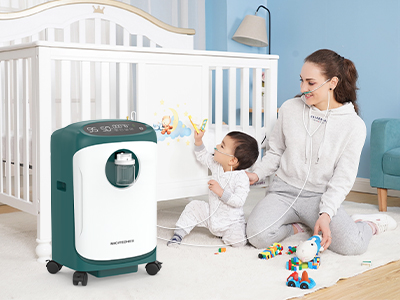03 Apr 2025
Breathing is effortless for most of us. But for children with respiratory disorders, every breath can be a challenge. When oxygen levels drop, the body struggles, energy fades, and simple activities become overwhelming. Oxygen concentrators serve as a vital support system, ensuring these children receive the oxygen they need to thrive.
In pediatric respiratory care, oxygen concentrators have revolutionized treatment. Unlike traditional oxygen tanks, which require frequent refills, concentrators provide a continuous supply by extracting oxygen from the surrounding air. For many families, these devices offer not just medical relief, but peace of mind.

Understanding Pediatric Breathing Disorders
Children’s lungs are still developing, making them particularly vulnerable to respiratory issues. Some conditions are temporary, while others require long-term management. The most common pediatric breathing disorders include:
Asthma – A chronic condition causing airway inflammation and difficulty breathing.
Bronchopulmonary Dysplasia (BPD) – A lung disease affecting premature infants who needed ventilator support at birth.
Cystic Fibrosis – A genetic disorder leading to thick mucus buildup in the lungs, causing frequent infections and breathing difficulties.
Pneumonia – A severe lung infection that can lead to dangerously low oxygen levels.
In all these cases, maintaining proper oxygen saturation is critical. Without it, growth, brain function, and overall well-being can suffer.
How Oxygen Concentrators Work
Oxygen concentrators are marvels of modern medical engineering. Instead of storing oxygen like a traditional tank, they work by pulling in ambient air, filtering out nitrogen, and delivering purified oxygen to the patient.
These devices are energy-efficient, cost-effective, and eliminate the need for constant refills. For children requiring long-term oxygen therapy, concentrators provide a sustainable and reliable solution.
Signs a Child May Need Supplemental Oxygen
It’s not always obvious when a child is struggling to get enough oxygen. Parents should watch for signs such as:
Persistent shortness of breath; Bluish tint on lips, fingertips, or toes; Chronic fatigue and difficulty staying active; Frequent headaches or dizziness; Poor weight gain and slow growth.
A pediatrician can perform pulse oximetry or arterial blood gas tests to determine if oxygen therapy is necessary.

Types of Oxygen Concentrators for Children
Not all oxygen concentrators are the same. Two primary types are:
Stationary Concentrators – Designed for home use, these provide a continuous flow of oxygen and are ideal for children who need round-the-clock support.
Portable Oxygen Concentrators (POCs) – Lightweight and battery-operated, these allow children to move freely, attend school, and travel without interruption.
When choosing a concentrator, factors like oxygen flow settings, noise level, and portability should be considered.
Safety Considerations for Home Use
Oxygen therapy is highly beneficial but requires careful handling. Key safety measures include:
Keeping the concentrator at least 10 feet away from open flames or heat sources.
Ensuring proper ventilation to prevent overheating.
Regularly cleaning and maintaining the device to ensure optimal performance.
Using only prescribed flow rates—too much oxygen can be as dangerous as too little.
Parents and caregivers should also have a backup power source in case of outages to avoid interruptions in oxygen delivery.
Benefits of Oxygen Therapy in Children
When a child receives the right level of supplemental oxygen, the difference is profound. Some key benefits include:
Increased energy and activity levels
Improved sleep quality and reduced nighttime breathing difficulties
Better cognitive function and focus in school
Stronger immune system and fewer hospitalizations
Oxygen therapy doesn’t just sustain life—it enhances it.
Caring for a Child on Oxygen Therapy
For parents, managing a child’s oxygen therapy can feel overwhelming at first. However, with proper guidance and a few adjustments, it becomes part of daily life. Some essential tips include:
Creating a Routine – Regularly monitoring oxygen levels and following the prescribed treatment plan.
Ensuring Mobility – Using portable concentrators or oxygen backpacks to maintain an active lifestyle.
Educating Others – Informing teachers, caregivers, and friends about the child’s condition and emergency procedures.
With the right approach, children on oxygen therapy can lead full, joyful lives.
Future Innovations in Pediatric Oxygen Therapy
The future of oxygen therapy is bright. Advances in technology are making concentrators smaller, quieter, and more efficient. Some upcoming innovations include:
Smart oxygen concentrators with remote monitoring and AI-driven flow adjustments.
Wearable oxygen devices that provide real-time oxygen delivery based on activity levels.
Improved battery life for portable units, allowing greater freedom of movement.
As research continues, children with breathing disorders will have access to even more effective and comfortable solutions.
Conclusion: Empowering Parents and Protecting Children
For children with respiratory conditions, oxygen concentrators are more than just medical devices—they are lifelines. They provide the oxygen necessary for growth, development, and a higher quality of life.
Parents and caregivers play a crucial role in ensuring safe and effective oxygen therapy. By staying informed, choosing the right equipment, and following medical advice, they can help their children breathe easier and live healthier.
Every breath counts. And with the right support, every child has the chance to thrive.
Keywords: oxygen concentrator
Originally published 03 Apr 2025, updated 03 Apr 2025.